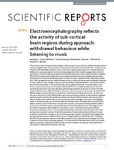Electroencephalography reflects the activity of sub-cortical brain regions during approach-withdrawal behaviour while listening to music
| dc.contributor.author | Daly, I | |
| dc.contributor.author | Williams, D | |
| dc.contributor.author | Hwang, F | |
| dc.contributor.author | Kirke, A | |
| dc.contributor.author | Miranda, ER | |
| dc.contributor.author | Nasuto, SJ | |
| dc.date.accessioned | 2019-07-19T13:47:13Z | |
| dc.date.issued | 2019-07-01 | |
| dc.identifier.issn | 2045-2322 | |
| dc.identifier.issn | 2045-2322 | |
| dc.identifier.other | 9415 | |
| dc.identifier.uri | http://hdl.handle.net/10026.1/14657 | |
| dc.description.abstract |
<jats:title>Abstract</jats:title><jats:p>The ability of music to evoke activity changes in the core brain structures that underlie the experience of emotion suggests that it has the potential to be used in therapies for emotion disorders. A large volume of research has identified a network of sub-cortical brain regions underlying music-induced emotions. Additionally, separate evidence from electroencephalography (EEG) studies suggests that prefrontal asymmetry in the EEG reflects the approach-withdrawal response to music-induced emotion. However, fMRI and EEG measure quite different brain processes and we do not have a detailed understanding of the functional relationships between them in relation to music-induced emotion. We employ a joint EEG – fMRI paradigm to explore how EEG-based neural correlates of the approach-withdrawal response to music reflect activity changes in the sub-cortical emotional response network. The neural correlates examined are asymmetry in the prefrontal EEG, and the degree of disorder in that asymmetry over time, as measured by entropy. Participants’ EEG and fMRI were recorded simultaneously while the participants listened to music that had been specifically generated to target the elicitation of a wide range of affective states. While listening to this music, participants also continuously reported their felt affective states. Here we report on co-variations in the dynamics of these self-reports, the EEG, and the sub-cortical brain activity. We find that a set of sub-cortical brain regions in the emotional response network exhibits activity that significantly relates to prefrontal EEG asymmetry. Specifically, EEG in the pre-frontal cortex reflects not only cortical activity, but also changes in activity in the amygdala, posterior temporal cortex, and cerebellum. We also find that, while the magnitude of the asymmetry reflects activity in parts of the limbic and paralimbic systems, the entropy of that asymmetry reflects activity in parts of the autonomic response network such as the auditory cortex. This suggests that asymmetry magnitude reflects affective responses to music, while asymmetry entropy reflects autonomic responses to music. Thus, we demonstrate that it is possible to infer activity in the limbic and paralimbic systems from pre-frontal EEG asymmetry. These results show how EEG can be used to measure and monitor changes in the limbic and paralimbic systems. Specifically, they suggest that EEG asymmetry acts as an indicator of sub-cortical changes in activity induced by music. This shows that EEG may be used as a measure of the effectiveness of music therapy to evoke changes in activity in the sub-cortical emotion response network. This is also the first time that the activity of sub-cortical regions, normally considered “invisible” to EEG, has been shown to be characterisable directly from EEG dynamics measured during music listening.</jats:p> | |
| dc.format.extent | 0-0 | |
| dc.format.medium | Electronic | |
| dc.language | en | |
| dc.language.iso | en | |
| dc.publisher | Nature Research (part of Springer Nature) | |
| dc.subject | Acoustic Stimulation | |
| dc.subject | Adult | |
| dc.subject | Brain | |
| dc.subject | Brain Mapping | |
| dc.subject | Electroencephalography | |
| dc.subject | Female | |
| dc.subject | Humans | |
| dc.subject | Magnetic Resonance Imaging | |
| dc.subject | Music | |
| dc.subject | Young Adult | |
| dc.title | Electroencephalography reflects the activity of sub-cortical brain regions during approach-withdrawal behaviour while listening to music | |
| dc.type | journal-article | |
| dc.type | Article | |
| plymouth.author-url | https://www.ncbi.nlm.nih.gov/pubmed/31263113 | |
| plymouth.issue | 1 | |
| plymouth.volume | 9 | |
| plymouth.publication-status | Published online | |
| plymouth.journal | Scientific Reports | |
| dc.identifier.doi | 10.1038/s41598-019-45105-2 | |
| plymouth.organisational-group | /Plymouth | |
| plymouth.organisational-group | /Plymouth/Faculty of Arts, Humanities and Business | |
| plymouth.organisational-group | /Plymouth/Faculty of Arts, Humanities and Business/School of Society and Culture | |
| plymouth.organisational-group | /Plymouth/REF 2021 Researchers by UoA | |
| plymouth.organisational-group | /Plymouth/REF 2021 Researchers by UoA/UoA33 Music, Drama, Dance, Performing Arts, Film and Screen Studies | |
| plymouth.organisational-group | /Plymouth/Users by role | |
| plymouth.organisational-group | /Plymouth/Users by role/Academics | |
| dc.publisher.place | England | |
| dcterms.dateAccepted | 2019-06-03 | |
| dc.rights.embargodate | 2019-7-24 | |
| dc.identifier.eissn | 2045-2322 | |
| dc.rights.embargoperiod | Not known | |
| rioxxterms.funder | Engineering and Physical Sciences Research Council | |
| rioxxterms.identifier.project | Brain-Computer Interface for Monitoring and Inducing Affective States | |
| rioxxterms.versionofrecord | 10.1038/s41598-019-45105-2 | |
| rioxxterms.licenseref.uri | http://www.rioxx.net/licenses/all-rights-reserved | |
| rioxxterms.licenseref.startdate | 2019-07-01 | |
| rioxxterms.type | Journal Article/Review | |
| plymouth.funder | Brain-Computer Interface for Monitoring and Inducing Affective States::Engineering and Physical Sciences Research Council |


